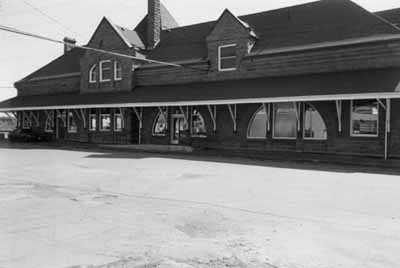VIA Rail/Canadian National Railways Station
Heritage Railway Station of Canada
Amherst, Nova Scotia

General view
(© DFA, Barry Moody, 1992.)
Address :
Station Street, Amherst, Nova Scotia
Recognition Statute:
Heritage Railway Stations Protection Act (R.S.C., 1985, c. 52 (4th Supp.))
Designation Date:
1992-11-06
Dates:
-
1907 to 1908
(Construction)
Event, Person, Organization:
-
Intercolonial Railway
(Organization)
-
William B. Mackenzie, chief engineer, Moncton regional office, Intercolonial Railway
(Architect)
Other Name(s):
-
Intercolonial Railway Station
(Other Name)
-
Amhert Intercolonial Railway Station
(Other Name)
-
Canadian National Railways Station
(Other Name)
Research Report Number:
RS-134
Description of Historic Place
The VIA Rail/Canadian National Railways (CNR) Station at Amherst is a one-and-a-half-storey, red sandstone railway station, built between 1907 and 1908. It is located in the town of Amherst. The formal recognition is confined to the railway station building.
Heritage Value
The VIA Rail/Canadian National Railways Station at Amherst represents the growth and prosperity of Nova Scotia at the beginning of the 20th century, and the role of the Intercolonial Railway Company (ICR) in the economic development of small towns. Strategically placed on the rail link between Nova Scotia and central Canada, Amherst became an important industrial and service centre. The present station reflects increasing demands for passenger and freight services and the expectation of continued growth.
The large size and impressive design of the VIA Rail/Canadian National Railways Station at Amherst reflects the significance of Amherst to the ICR and its expectations for future growth. Deliberately built to dominate its surroundings and provide more space than was required, it remains one of the largest railway stations in the province of Nova Scotia. Its construction of local red sandstone in the Romanesque Revival style corresponds to the style and materials of local buildings of the same era.
The station retains its relationship with the long platform beside the station and with railway-related buildings in the neighbourhood.
Sources: Heritage Character Statement, The Via Rail/CNR Station, Amherst, Nova Scotia, March 1993; Delta Four Associates Inc., Harry Jost and Barry Moody, Railway Station Report 134, VIA Rail/ Canadian National Railways Station, Amherst, Nova Scotia.
Character-Defining Elements
Character-defining elements of the VIA Rail/Canadian National Railways Station at Amherst include: its form and massing, consisting of a long, high, rectangular block, capped with a steep, hipped roof; its Romanesque Revival style, evident in the towers, the stone chimney stacks, the arched, tripartite, masonry openings, and the deeply shadowed canopy; its features typical of early-20th-century railway stations, including the hipped roof, the deep platform canopy, the large wooden brackets, and the projecting operator’s bay; the deep platform canopy, sitting below the eaves line, and supported on chamfered scissor brackets resting on stone corbels; the prominent moulded cornice above the platform canopy, with deep shadow lines created by projecting courses of masonry; the small dormer with stepped detailing on each of the track (west), town (east) and north façades; the large, two-storey bay on each of the track and town façades, terminating in a pyramidal roof on the track side, and in a parapet with stepped detailing on the town side; the deliberately irregular pattern of openings; the configuration of each tripartite opening, including semi-circular, tripartite, windows on all elevations, semi-circular, tripartite openings with double doors, transom and sidelights, segmentally arched tripartite windows in the second-storey bays, and rectangular tripartite windows in the ground-floor bays; the surviving original wood sash and multi-light storm windows; the character and high quality of the masonry work, consisting of local red sandstone laid rock-faced in broken courses; the surviving original features of the elegant, Edwardian-style interior, including coffered ceilings, intricately patterned in matched lumber, walls divided into contrasting panels of vertical, horizontal and diagonal boarding, leaded glass sidelight in the ladies’ waiting room and a fireplace in the ladies’ waiting room.